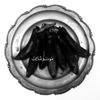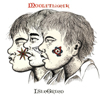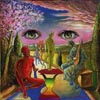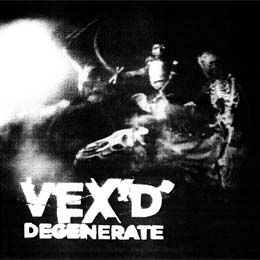 While it would be unfair to say that Monogamy is not as good as Land of Kush's previous album, Against the Day, it is fair to say that this present album is not as forgiving as the last one. Sam Shalabi's combination of Arabic traditional motifs and instruments with jazz, free improvisation and electronics has moved further out to truly stretch any notion of genre to breaking point. Add to that a sense of toilet humor and a deeper conceptual edge and this is an album that makes for an album that will no doubt surprise me every time I listen to it.
While it would be unfair to say that Monogamy is not as good as Land of Kush's previous album, Against the Day, it is fair to say that this present album is not as forgiving as the last one. Sam Shalabi's combination of Arabic traditional motifs and instruments with jazz, free improvisation and electronics has moved further out to truly stretch any notion of genre to breaking point. Add to that a sense of toilet humor and a deeper conceptual edge and this is an album that makes for an album that will no doubt surprise me every time I listen to it.
- Administrator
- Albums and Singles
 While it would be unfair to say that Monogamy is not as good as Land of Kush’s previous album, Against the Day, it is fair to say that this present album is not as forgiving as the last one. Sam Shalabi’s combination of Arabic traditional motifs and instruments with jazz, free improvisation and electronics has moved further out to truly stretch any notion of genre to breaking point. Add to that a sense of toilet humor and a deeper conceptual edge and this is an album that makes for an album that will no doubt surprise me every time I listen to it.
While it would be unfair to say that Monogamy is not as good as Land of Kush’s previous album, Against the Day, it is fair to say that this present album is not as forgiving as the last one. Sam Shalabi’s combination of Arabic traditional motifs and instruments with jazz, free improvisation and electronics has moved further out to truly stretch any notion of genre to breaking point. Add to that a sense of toilet humor and a deeper conceptual edge and this is an album that makes for an album that will no doubt surprise me every time I listen to it.
Thanks to the employment of what can only be described as a nymphomaniac model of Stephen Hawking's voice synthesiser, "Scars" is at first a difficult piece to get to grips with. As the machine recites line after line of obscenities (ranging from the plain dirty to the outright bizarre), the music bobs and slashes as The Egyptian Light Orchestra (credited as 23 musicians on this recording alone) follow Shalabi's directions into uncharted territories. Contrasting the insensitive, mechanical sexual stream of consciousness is a powerful, emotive and human performance by Elizabeth Anka Vajagic; her vocals capturing all the drama, both real and imagined, of a relationship whereas the synthetic voice just encapsulates that automatic depravity that the information age has opened the gates to.
On "Tunnel Visions," Katie Moore's vocals are hung on the beautiful scaffolding of ELO's delicate playing. However, a Zappa-esque turnaround brings the piece into a far jazzier territory as an untamed sax skronks over the solid drum groove. The piece dissolves into the next and unfortunately that sickly synthesised voice returns on "Fisherman." While the music underneath is fantastic, I find it hard to get past that computerised vocalist. When Ariel Engle's vocals take over, the piece leaps out of the stereo with far more vigour. The stabbing rhythm allows her voice, the sax and the electronics to soar.
The centrepiece of Monogamy is the title track which recalls the best parts of Against the Day but improves on them (raising an already high bar). Squelching electronics bluster through the music like a strong Sirocco wind. The vocals (by yet another vocalist, Molly Sweeney) dance over the dry, hot and captivating music; strong rhythms and textures creating vivid mental images of north African towns in the dead of night; lovers coming together and breaking apart in endless cycles.
Land of Kush has rapidly become Shalabi's best project, I have always enjoyed his music but found him to be somewhat inconsistent. With this new group and approach to songwriting, he has developed a stronger creative vision. Yet there are still small discrepancies that mar Monogamy. Without that voice synthesiser, this would be undoubtedly stronger than Against the Day but conceptually it works within the album’s themes of sexuality and relationships. At the moment, it is doing my head in but that is liable to change with time. However, everything else here is sublime: the playing, the singing and the overall presentation of the music is spot on. Along with Against the Day, this is certainly one of the most unique albums of recent years.
samples:
 
Read More
- Administrator
- Albums and Singles

A few months back, I sang the praises of Ural Umbo, a duo that Reto Mader is half of. After hearing this album, and one from his other project, Sum of R, I can definitely say that it is Mader who is largely responsible for all of these bands creating work that is awash in a multitude of grays, and here it only slightly obscures a variety of approaches that are not necessarily as dark or as heavy as his previous output may lead one to suspect.
 
Now, don’t take that to imply that this is all Tangerine Dream and rays of light and all that hippy crap, not at all.The deep, sinister swell of Hell’s church organs that pervade "Early Morning Fog" certainly aren’t uplifting at all, and even when the bells come in to add a bit of levity, it still stays as a dark, undulating miasma of sound.The heavy sustained harmonium and rhythmic clicks of "The Human Factor" channel some perverse take on film scoring, but still goes off on its own singular dark tangent.
The remaining tracks are somewhat lighter in their approach, but again, not inappropriately so.The open guitar strums and field recording elements of "Between the Devil and the Deep Blue Sea" give an organic spaciousness that is definitely not as dark as it could be.The chiming guitar of "Incremental Shift" is a lot more buoyant than the percussive scrapes and noisy drone that surround it, but it stays the focus of the track, rather than the harsher elements."Temporal Resolutions" also focuses more on a soft, Mellotron type sound that are just slightly obscured by delicate static, with reverberated pulses and clicks above.As it draws to a close, it removes some of the layers and distortion to reveal the soft, textural elements that lay beneath.
Textural elements pervade the album throughout:"Organ-Origami" keeps dramatic elements hidden beneath a thin layer of digitally treated distortion to give it a distinct sound that suggests something more akin to noise, but with a bevy of other things going on underneath.When the noise spikes and then disappears, only the beautiful underlying sounds remain, like a storm coming to its inevitable end."Garden of the Lower Lights" puts shimmering icy tones alongside a tremolo laced bit of guitar to juxtapose the dynamic rhythmic swell with the otherwise leaden sounds.
The distinctly gray raincloud sound that characterizes Meto’s work in Ural Umbo and Sum of R is present as well, but on his own, he is more apt to allow the light to shine through, revealing complexities and melodies otherwise hidden.By no means is there an overwhelming sense of levity:it is still a dark album with sinister undertones.Meto’s careful construction of sound is what makes it unique, and thus its greatest strength.
samples:
 
Read More
- Administrator
- Albums and Singles

Unlike the previous three box sets from the wonderful Pica Disk label, Necro Acoustic is not as much about surveying a career as it is showcasing the full repertoire of Drumm. Sure, there’s archival material dating back to 1996 that has never seen the light of day, but there are two discs of purely new material, as well as some recent (but extremely limited) tracks as well.
The first disc in this set, Lights Out, is a mere half-hour, but as painful as it is, I don’t think anyone could stand for it to be any longer.Recorded between 2006 and 2008 using just two pulse generators, a filter, and feedback, Drumm builds a grating composition of punishing noise.The opener "Spraying the Weeds" begins innocent enough, with its deep space pulses and static that sound like a more sparse, brittle version of CCCC until a harsh ringing sound pierces through, swelling up to be more and more uncomfortable.The pain continues into "Blistering Statick," with the tinnitus inducing pitches contrasting against deep bass swells, and eventually an almost melodic layer, sounding almost like the cheap jingle of an ice cream truck.The short "Needleprick" cranks up the high end to ultrasonic territory:I don’t have a dog, but I wish I could see one respond to this little piece of pain.The massive closing "Idle Worship" is almost a pure endurance test:mid-range insect buzz and painful, overdriven high end create a wall of relatively static sound, with minor changes occurring as its 15 minute duration continues on.
The second disc, Malaise, is a reissue of a long out of print double cassette on Hospital Productions, presented here in 11 different tracks for convenience.While still harsh as all hell, there’s a bit more variation to the pieces here:the first has such a filtered sound it could be playing off of a cell phone, but occasionally lets loose into untreated blasts of noise.It’s not an overly abrasive one, but one that is more textural and varied.The third segment has a similar approach, with maximalist ambient passages focusing more on tonal dynamics than harshness.Tracks two and six fill the need for the harsh noise wall thing, the former’s jet engine rush and layered noise feels like a nod to the Incapacitants or other old school practitioners.Track nine, clocking in at 15 minutes, avoids the harsh route entirely to focus on walls of oscillator tones, like a massively sustained organ played as loud as possible, to create a more forceful approach.
Decrepit is the compilation disc of the batch, combining pieces recorded between 1998 and 2009, some of which have been previously released.The two part "Dilemma" was originally released as a one sided LP, but is two variations on the Kevin Drumm sound:the first part is cut up feedback and treated guitar noise, with the occasional puff of analog static, while the latter throws out an almost rhythmic bed of noise with sharp, cutting static on top.The tracks from a split LP with 2673 appear here as well:"Totemic Saturation" sounds like a techno synth patch in its death throes, buried amongst layers of harsh grime that grows to a massive swell, but never loses that bit of familiarity."The Blurry Stupor" is one where the harshness is restrained, allowing the multitude of sounds to be heard individually, creating a hazy sound collage rather than a digital enema.The remainder of the tracks stay more in the world of noise, from the painful noise sheets of "Stomach Acid" to the filtered static and fuzz, but with a digital sheen overall, of "Band Pass."
The other new and exclusive material here is No Edit, an hour long track in two parts using only the most rudimentary of sources:prepared guitar, EQ, two pedals, and a Marshall mini-amp.Because of its sparse instrumentation, there is an overall thinner sound:beginning with the noise immediately, one can almost hear the poor little amp in pain, vomiting out guitar squall resembling a detuned AM radio more than a Marshall stack.The focus is more on the scraping of strings, and the second half is a bit more mellow (or perhaps the amp just gave out at this point).The latter portions are subtler, focusing on sustained rattles and the occasionally overt string pluck.
Finally, the closing disc, Organ, is one of Drumm’s earliest works, which appeared heavily edited on the Comedy disc from 2000.Here, it is presented in its entirety:nearly 55 minutes of two organs blasting through guitar amps and effects.The structure is pretty rudimentary:there’s alternating sustained chords and key bashing throughout the duration, but power develops through the simplicity.The sound becomes this massive, monolith of noise that is subtly treated through pitch changes and effects as it goes on, but as a whole it takes the sound of such a "big" instrument and blows it up to epic, nearly absurd proportions.
Again, I’m sounding like a broken record, but Lasse Marhaug has done beautiful work, presenting the five discs in a clamshell box with a booklet full of pictures of Drumm's dilapidated old home in which most of the early material presented here was recorded, providing appropriate imagery for the sounds of grime and decay that are contained within. That, coupled with the variety of material presented makes this a great set:those less familiar with Drumm’s work can get a good overview of his career while the hardcore fans will find enough new material to enjoy.
samples:
 
Read More
- Administrator
- Albums and Singles
 This, the final part of David Tibet’s trilogy of revelations that began with Black Ships Ate the Sky, is his most dizzying and hallucinatory work yet. Stripping back the heavy guitars that have been creeping steadily into Current 93’s music, the songs here instead sound like they have been passed down through generations of Middle Eastern folk musicians. From the image of a young Tibet standing in front of Stonehenge on the back of the album to the lyrical themes of eternities, the weight of time hangs heavy around Baalstorm, Sing Omega. This is a surprising and rewarding change in tone for Current 93 that certainly ranks amongst Tibet's finest work yet.
This, the final part of David Tibet’s trilogy of revelations that began with Black Ships Ate the Sky, is his most dizzying and hallucinatory work yet. Stripping back the heavy guitars that have been creeping steadily into Current 93’s music, the songs here instead sound like they have been passed down through generations of Middle Eastern folk musicians. From the image of a young Tibet standing in front of Stonehenge on the back of the album to the lyrical themes of eternities, the weight of time hangs heavy around Baalstorm, Sing Omega. This is a surprising and rewarding change in tone for Current 93 that certainly ranks amongst Tibet's finest work yet.
Each of the three albums in this series focus on different facets of Tibet’s visions; the black ships destroying the heavens of the first album, the titanic Adam/Aleph character’s bloodstained features and now the cataclysmic Baalstorm sweeping over the horizon. While Tibet’s lyrics are rarely transparent, the songs on Baalstorm, Sing Omega are particularly dense in their imagery. Obviously Tibet is drawing even more on his vast readings not just in Coptic but also on a wider range of topics. The fallout of the nuclear "bikini blast" from Aleph at Hallucinatory Mountain manifests itself here with the repeated references to ions and aeons; "the infinite leak" having a half-life many times longer than the full lives of humanity.
The other striking aspect of Baalstorm, Sing Omega is how feminine it is; battles being waged by Amazonian warriors and an almost Joycean incorporation of women from Tibet’s life into symbolic beings throughout the album. Magical Molly Blooms and apocalyptic Anna Livia Plurabelles take on the aspects of gods and divine symbols. The idea of motherhood, fertility and a new world gestating in an amniotic sea permeates the album: "Pulling down the moon and sun/From the thighs of the queen... The bump, the bribe, the breasts."
The music itself is also less masculine than on the previous albums; the electric guitars replaced with more graceful and limber strings. In particular, Eliot Bates’ oud brings a sinuous element to the music, exotic and ancient melodies emerging from the bowels of the instrument. On "With Flowers in the Garden of Fires," his gorgeous playing combined with percussion (which appears to be a combination of Alex Neilson on a traditional kit and Eliot Bates on erbane and daf) creates a mesmerising musical arabesque. This is a long way both in time and space to Current 93’s usual western folk influence and, unlike the previous two albums, the music is gentler. Despite the obvious power of the electric guitar, the haunted waves of Baalstorm, Sing Omega will erode Aleph’s hallucinatory mountain.
Most of the album lacks the violence of the Aleph songs but that is not to say that this album remains completely sedate. The thumping piano refrain of "Baalstorm! Baalstorm!" propels an urgent Tibet as a mixture of Andrew Liles’ electronics and guitars create a fuzzy fog around the lyrics. This tempest gives way to the peaceful and utterly beautiful "Passenger Aleph in Name." James Blackshaw’s simple but bewitching glockenspiel motif repeats itself as the rest of the ensemble add texture and detail around it. As the music ripples outwards, John Contreras’ cello swells up like the calm tide after a maelstrom.
Yet this is not some seasonal bout of bad weather, this is a flood of mythological proportions (biblical is too restrictive a term considering the breadth of Tibet’s lyrics). Tibet’s Baalstorm appears to be occurring on a scale that is either too small ("the split of an atom") or too large to be fully comprehended. This epic is so layered and personalised (though Tibet thankfully includes some explanatory information in the sleeve notes) that it is impossible for me, after only a week, to fully come to grips with what is going on this album. However, by the end of the album, the feeling that something large, black, and revelatory is on the horizon is impossible to ignore. The thunderclaps, the sound of waves both oceanic and apocalyptic and Baby Dee’s fabulous electric organ come together on "I Dance Narcoleptic" to finish off the album (and perhaps the world) in style. Tibet’s insisting lyrics might be hard to believe but the conviction is frightening. Interspersed with children singing Omega, the music starts to spin as I am caught in a whirlpool and drown in the deeps of Tibet’s dreams. In the wake (or as I wake), the sound of Bill Fay’s voice drifts through the murk like a messenger from the heavens. Suddenly I am free to take a breath again.
samples:
 
Read More
- Administrator
- Albums and Singles
 Billed by member Lars Horntveth and Ninja Tune as a Fela Kuti/Frank Zappa/progressive rock hybrid, Jaga Jazzist's latest is even more expansive and inclusive than that description suggests. Unpredictable smatterings of funky bass, over-driven guitar solos, synth jams, Steve Reich-ian hypno-patterns, pleasing stylistic jumps, and a much appreciated sense of humor are all present on One-Armed Bandit and without a single instance of forced splicing or embarrassing technical posturing.
Billed by member Lars Horntveth and Ninja Tune as a Fela Kuti/Frank Zappa/progressive rock hybrid, Jaga Jazzist's latest is even more expansive and inclusive than that description suggests. Unpredictable smatterings of funky bass, over-driven guitar solos, synth jams, Steve Reich-ian hypno-patterns, pleasing stylistic jumps, and a much appreciated sense of humor are all present on One-Armed Bandit and without a single instance of forced splicing or embarrassing technical posturing.
Jaga Jazzist draw from so many influences that accurately pinning down the sound on their latest album is an almost impossible task. References to Steve Reich make just as much sense as allusions to Janko Nilovic, Fela Kuti, or any one of the fusion-era jazz powerhouses, like Miles Davis or Mahavishnu Orchestra. So, calling it something like a rock-jazz hybrid is about as helpful as saying it has lots of notes, often played in rapid succession. What Jaga Jazzist have done so well on this record is blend all of their influences to the point of complete synthesis: they not only play killer jazz and classical licks, they own them and blend them as if it were the most natural thing in the world. This is easily demonstrable: just listen to the dark and brooding rock of "220 V/Spektral" and witness how effortlessly it segues into the looping organs, towering horns, and skittering drum 'n' bass rhythms of "Toccata." At first blush these tunes don't seem reconcilable, but Jaga draws them together flawlessly, connecting the dots between their own electronic past, library music, jazz, and progressive rock, sometimes on the same song.
But One-Armed Bandit isn't a great record thanks to its showy virtuosity and seamless blending alone. Each of the album's nine songs features a strong melodic or rhythmic center and a whole smörgåsbord of unusual diversions and thematic shifts that entertain directly and viscerally. In other words, One-Armed Bandit isn't a difficult or complex-for-complexity's-sake record. There are as many tight and memorable hooks as there are impressive solos or complex passages. Much of its success in this regards stems from the band's ability to laugh at themselves. The album's artwork, which is centered on casino imagery, finds its analog on the album's first song, which quickly demonstrates that this isn't going to be simply a wank-fest for technique-obsessed musicians. While keeping things tight and forward moving, Jaga Jazzist toss together sax solos and horn sections, thick-as-concrete bass lines with enough funk to liberate most asses, guitar leads that would make almost anyone contort their face in Van Halen-like glory, and a percussion performance with energy enough to make Buddy Rich proud. In other words, the song kicks ass in the first two minutes, generating enough energy to power the Starship Enterprise for the duration of The Next Generation. They then throw in flutes, xylophones, any number of keyboards, and other miscellaneous accompaniment before breaking out a weirdo surprise in the middle: an orchestra of slot machines erupting in unison, like a symphony of gamblers diving into a sea of arpeggios and victoriously flashing lights. It's a dizzying moment, especially since the band manages to bounce the rhythm around like a skipping record, and it illustrates very well the spirit of the rest of the record.
Without even a hint of choppiness or awkwardness, Jaga Jazzist fill One-Armed Bandit up with all manner of surprises and killer tunes, and they completely out-do themselves on each and every song, showing off their songwriting chops and technical ability at once. I have probably listened to this record more than any other this year and I'm finding that it continues to grow on me nearly six months after its release.
samples:
 
Read More
- Administrator
- Albums and Singles
 The long-awaited (and almost instantly sold-out) vinyl debut from the less prolific half of Natural Snow Buildings continues Solange Gularte’s fine tradition of dreamlike, disquieting, and temporally dislocated ethno-ambience. While perhaps not as consistently graceful and brilliant as her solo contributions to 2008’s epic The Snowbringer Cult, Modlitewnik is nevertheless scattered with some of her most singular and otherworldly music yet.
The long-awaited (and almost instantly sold-out) vinyl debut from the less prolific half of Natural Snow Buildings continues Solange Gularte’s fine tradition of dreamlike, disquieting, and temporally dislocated ethno-ambience. While perhaps not as consistently graceful and brilliant as her solo contributions to 2008’s epic The Snowbringer Cult, Modlitewnik is nevertheless scattered with some of her most singular and otherworldly music yet.
Modlitewnik ("prayer book" in Polish) opens in supremely haunting fashion, as "Night Dew Call" fades in with sad, vaporous, and almost sacred-sounding wordless vocals amidst a haze of reverb and spectral flutes or pipes. Unexpectedly, however, it lasts less than two minutes before transitioning into the comparatively cheerier, but considerably less impressive "Ver Sacrum," which approximates pastoral Irish folk filtered through a blurred, hallucinatory fog.Fortunately, the bulk of the album is very much in the vein of the initial eerie ambiance, though Gularte breaks up the sequencing a bit with occasional divergences like the relatively straightforward acoustic guitars of "Fire Flies."
Solange’s current aesthetic can be best summarized as "early traditional music warped into something very lysergic and pagan-sounding."What makes her work so fascinating is both the enormous breadth of her inspiration and her unique skill at evoking occult, earthy, and timeless atmospheres.Isengrind’s music simply does not sound like it is being made in the present time, nor does it sound like Gularte has any interest at all in the culture that the modern world is currently producing (aside from perhaps noise/drone music).Instead, this album is a bubbling cauldron of Norse and Babylonian mythology, macabre Romanian lore, inscrutable runes, timeless spirituality, enigmatic art, and folk music culled from India, the British Isles, and the Far East.In fact, the weakest song on the album (the '60s acid-folk-tinged "I Know Where I Am Going") is the only one that overtly nods to relatively contemporary times at all.
There are a few other songs that I don’t particularly care for, but most of the album is extremely good and sometimes stunning. Gularte has a distinct knack for making tambourines, pipes, and sitars sound sinister and ritualistic.She’s also quite adept at some less tangible things, like making sounds echo and bleed together to the perfect degree or allowing songs to unfold at a natural, unhurried pace.Much of the time, Modlitewnik sounds like a very inspired album by a very odd woman with a houseful of exotic instruments and esoteric books.At its best, however, it sounds far more like I just blundered into a forbidden grotto and that a circle of ecstatically-tranced she-druids is now closing in on me, drawing their curved knives for a blood sacrifice.
Samples:
 
Read More
- Administrator
- Albums and Singles
 Painting a picturesque landscape using nothing but melody and ingenuity has long been at the epicenter of avant pursuits. Lustrous locks of tonal notes floating in the breeze as each counterpart unfurls, becoming sinewy strings of texture set against a golden background. It is among such a romantic setting that the works of Fabio Orsi glimmer, catching the sun’s rays and beaming it back to the world as beautifully constructed song paintings. On his latest, Random Shades of Day, Orsi continues to emerge as a master of transforming music into mood through four pieces of richly layered drone set against a dreamy landscape.
Painting a picturesque landscape using nothing but melody and ingenuity has long been at the epicenter of avant pursuits. Lustrous locks of tonal notes floating in the breeze as each counterpart unfurls, becoming sinewy strings of texture set against a golden background. It is among such a romantic setting that the works of Fabio Orsi glimmer, catching the sun’s rays and beaming it back to the world as beautifully constructed song paintings. On his latest, Random Shades of Day, Orsi continues to emerge as a master of transforming music into mood through four pieces of richly layered drone set against a dreamy landscape.
Random Shades of Day is no small feat. Surrounded by two discs of out of print and unreleased material, it rewards those patient enough to absorb the older works of Orsi. The deep catalog of Orsi releases is barely touched on Random Shades of Day but the older (but just as touching) music proves as the perfect accompaniment to the new. Following Orsi’s subtle progression, Random Shades of Day allows the unfamiliar plenty of chances to understand Orsi’s point of view.
However, Random Shades of Day is dominated by the four new recordings of the same name that adroitly mimic the atmosphere at various stages of a typical day. Each part of "Random Shades of Day" builds upon its predecessor. Part I is a slow grind as the sun peaks over the horizon, as shifts in tone methodically seesaw through bursts of electronic rays. The consonance bleeds into Part II as the sun reaches its apex. The melody turns heavy as the sun parades across the sky, drenching everything in ultraviolet light and heavy humidity. The same droning keys and meditative effects push and pull throughout the first half Random Shades of Day, illuminating Orsi’s true-to-title vision as it metastasizes into art. As the sun begins to set near the end of Part II, the minor keys take over and the rhythm speeds up. The track becomes translucent; the layers are being peeled back as the song blossoms into the expanses of dusk. The effects and electronics swirl together like the oranges, yellows, and reds of the evening sky.
The back half begins coldly as the chill of the moon replaces the warmth of the sun as the album’s warmer tones are devoured by windy chords and ominous tones. Random Shades of Day turns bleak as midnight approaches, calling to the supernatural in its stealthy approach. Part III slows to a crawling pace, capturing the slumbering state. The real becomes ethereal and the day’s images are corrupted into nightmarish imagery. It isn’t until Part IV that the spell is broken and a peaceful rest settles on Orsi.
Random Shades of Day is another strong piece in the voluminous canon of Fabio Orsi. Yet paired with older work, it only grows in power and prestige. Orsi has come a long way and Random Shades of Day puts his meteoric trajectory on full (and magnificent) display.
samples:
Read More
- Administrator
- Albums and Singles
 Albums built around a concept of exploring an imaginary land don’t comealong too often and it’s an even rarer occasion when it looks likethey’re worthy of more than a cursory holiday.Black Sun Productions member Drazen brings to life an audio journeythat defies the awkwardness of the concept and demands repeat visits onthis his debut solo album.
Albums built around a concept of exploring an imaginary land don’t comealong too often and it’s an even rarer occasion when it looks likethey’re worthy of more than a cursory holiday.Black Sun Productions member Drazen brings to life an audio journeythat defies the awkwardness of the concept and demands repeat visits onthis his debut solo album.Black Sun Productions
While the album’s tracks are titled, recorded and programmed on CD aseight different pieces Visions Ov Anarcadia is best enjoyed in onesitting as a single flowing voyage. Although it’s not really until suchand such minutes in on “Somethings Valley” (also known as track three)that the album title really begins to make sense.
The song’s combination of controlled lushness, lengthy processed pipemelody and the creation of an expansive area brings to mind vividmental pictures of open spaces. This bare melody comes in waves,undulating almost like its being blown across hills that aren’t there.It’s the sensation of movement here from the warm techno core that gives the impression of travelling throughAnarcadia without moving. But with this is an icy sliver of sadness inthe realization that Anarcadia doesn’t really exist, at least on thisphysical plane.
From there the album explores quietly clattering Coil prayer menacewith “Mount Coum,” and wanders fog-bound along the distantly murkyshorelines of “Cape Cock,” whose highlight is a sinister baroque gothictheme which rises only once from the song’s depths like Kubrick’smonolith. A heartbeat and “Ov Arc”s wavering moan of breath-like soundleads slowly into the tribalistic and surprisingly powerful technofinale of “Mount Smegma,” which drives as much for the head as thefloor. This album’s combination of innocence, darkness, sadness andexploration is further proof of the Black Sun stamp as a mark ofquality in an unreliable but predictable musical climate.
samples:
Read More
- Administrator
- Albums and Singles
 An entire summer passed without me publishing a single album review forBrainwashed, or any other site for that matter. Compact discs andpress releases arrived via post regularly, typically finding a home inpiles at the far end of my desk, next to a dust-collecting drummachine. Call it a lack of motivation, call it laziness, yet, on this unseasonably warm autumnnight, I have returned. It took thebest album of 2005 to accomplish that.
An entire summer passed without me publishing a single album review forBrainwashed, or any other site for that matter. Compact discs andpress releases arrived via post regularly, typically finding a home inpiles at the far end of my desk, next to a dust-collecting drummachine. Call it a lack of motivation, call it laziness, yet, on this unseasonably warm autumnnight, I have returned. It took thebest album of 2005 to accomplish that.
Planet Mu
Merciless and astounding, Degenerate is a shock to theproverbial system, a savage hate crime against the softened eardrums ofwimpy dance rock hipsters and trendy techno fashionistas. The duobehind Vex'd conjure up an unflinching and bleak industrial vision ofelectronic music, the likes of which havent been seen since Scorn's Greetings from Birmingham.The solitary opening bleeps of "Pop Pop V.I.P." resurrect the elatedtones of Sweet Exorcist's pathbreaking classic "Testone" beforeerupting into a grisly cacophony of neck-snapping snares andstomach-churning rumbles. "Thunder" slashes the tempo right in half,leaving only an eviscerated aural carcass. The twisted uptempo rhythmsreturn on "Angels," a sub-bass monster specked with a particularlyghastly film sample. This dancefloor-accessible style of low-endworship dominates the album, from the dubby inflections of "Venus" and"Fire" to the unstoppable breakbeat monoliths of "Gunman" and "LionV.I.P." A notable deviation from this effective formula comes on "Cold"with its distant strings and gurgling, groaning synthy squelches,presenting an atmospheric, more pensive and, atypically, beatlessversion of the now undeniable Vex'd sound. As if an entire album ofsuch power weren't enough, Planet Mu thankfully includes a second discof bonus tracks culled largely from previously released 12" records.The original version of "Lion," a highlight among this shorter set,digs a distorted bleepy melody out of the crates that might tantalizeformer ravers longing for the sounds of forgotten warehouse parties.
To approach Degenerate as the product or even arelative of the U.K. dubstep/sublow/grime scenes would do it an immenseinjustice, as Vex'd truly have compiled a peerless document that speaksto our grim, chaotic, blood-drenched world without hardly saying aword.
samples:
Read More
- Bill Ryubin
- Albums and Singles
 The prospect of new material from Mick Harris's project mightn't get hearts racing as it would have done a few years ago, but this EP of four mixes from 'Plan-B,' and two exclusive tracks show a real return to form. Whenever I hear a new Scorn release, I always hope he'll have added some new twist or surprise, and for once he's showing some interest in moving away from his established style.Hymen
The prospect of new material from Mick Harris's project mightn't get hearts racing as it would have done a few years ago, but this EP of four mixes from 'Plan-B,' and two exclusive tracks show a real return to form. Whenever I hear a new Scorn release, I always hope he'll have added some new twist or surprise, and for once he's showing some interest in moving away from his established style.Hymen
The dub influences have been slowly edged out since his move to Hymen Records, leaving just the the slow-motion, lumbering hip-hop beats and abstract bass rumbles. Thankfully though, he hasn't lost his knack for getting your head pounding, and as the first few crunchy beats of "Hedrake" lurched into existence, I stopped caring whether he has re-invented himself; okay, it's nothing he hasn't done a thousand times before, but after years of honing his approach, he's getting it down to a fine art. His ultra-minimal, stripped-down sound gets a little drab on two of the 'beat mix' remixes, being little more than mildly engaging drum tracks and looped fragments. It's the remaining three tracks on 'Governor,' though, which elevate it above his recent work. The more abstract, masterful "Collections" focuses more on the eerie texture and unsettling ambience. The added dimension makes a world of difference, and more of this standard would see him re-established as the master of this genre.
The closing two remixes are entirely un-Scorn-like, and are a real breath of fresh air, with a marked move away from the pounding beats towards a fresh, less immediate exploraion of eerie abstractions. The first is a brief, looped and stretched piano loop, while the second is a superb, energetic Somatic Responses mix of "The Snow Hill." Each confirm that future Scorn releases are something to get excited about again.
 
samples:
 
Read More